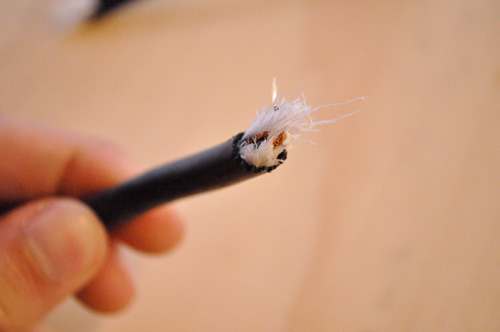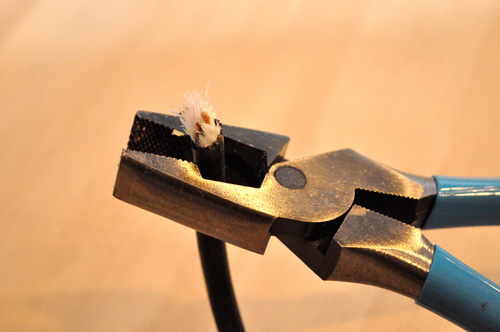Assessing the Damage: Evaluating the Extent of the Cut
When dealing with a cut power cord, it’s essential to assess the damage to determine the best course of action. A minor cut may only require a simple repair, while a more severe cut may necessitate replacement. To evaluate the extent of the damage, inspect the cord carefully, looking for signs of wear, fraying, or exposed wiring.
Check the cord for any visible signs of damage, such as cuts, abrasions, or burn marks. If the damage is minor, you may be able to repair the cord using basic tools and materials. However, if the damage is more extensive, it’s recommended to seek professional help or replace the cord altogether.
When inspecting the cord, pay particular attention to the area around the cut. Check for any signs of electrical arcing or burning, which can indicate a more serious problem. If you notice any of these signs, it’s best to err on the side of caution and seek professional help.
By carefully assessing the damage, you can determine the best course of action for repairing or replacing the cut power cord. This will help ensure your safety and the functionality of your equipment. In the next section, we’ll discuss the necessary tools and materials required to fix a cut power cord.
Gathering Essential Tools and Materials for Repair
To fix a cut power cord, you’ll need a few essential tools and materials. The specific tools required may vary depending on the type of cord and the extent of the damage. However, here are some common tools and materials that you may need:
Wire strippers: These are used to remove the insulation from the wires. You can use manual or automatic wire strippers, depending on your preference. Klein Tools wire strippers are a popular choice among electricians and DIYers.
Electrical tape: This is used to insulate the wires and protect them from moisture and abrasion. 3M electrical tape is a high-quality option that is widely available.
Replacement wire: If the damage to the cord is extensive, you may need to replace the entire wire. Make sure to choose a replacement wire that is compatible with the original cord.
Other materials: You may also need other materials, such as wire nuts or connectors, depending on the type of cord and the repair required.
When gathering tools and materials, make sure to choose high-quality options that meet the relevant safety standards. This will help ensure that your repair is safe and effective.
In the next section, we’ll provide a step-by-step guide on how to fix a cut power cord using these tools and materials.
Step-by-Step Instructions for Repairing a Cut Power Cord
Now that you have gathered the necessary tools and materials, it’s time to start the repair process. Here’s a step-by-step guide on how to fix a cut power cord:
Step 1: Strip the Wires
Use wire strippers to remove the insulation from the wires. Be careful not to damage the wires during this process. If you’re using a manual wire stripper, make sure to strip the wires in a consistent and controlled manner.
Step 2: Twist and Tape the Wires
Once the wires are stripped, twist them together to form a secure connection. Use electrical tape to hold the wires in place. Make sure the tape is applied tightly and evenly to prevent any electrical shock or fire hazards.
Step 3: Apply Electrical Tape
Apply additional electrical tape to the repaired area to provide extra insulation and protection. Make sure the tape is applied smoothly and evenly to prevent any wrinkles or air pockets.
Step 4: Inspect the Repair
Once the repair is complete, inspect the area to make sure it’s secure and safe. Check for any signs of electrical shock or fire hazards, and make sure the repair is done to the highest standards.
By following these steps, you should be able to fix a cut power cord safely and effectively. Remember to always prioritize safety when working with electrical components, and seek professional help if you’re unsure about any part of the repair process.
Testing the Repaired Power Cord for Safety
After repairing a cut power cord, it’s essential to test it for safety to ensure it’s functioning properly and won’t cause any electrical shock or fire hazards. One simple way to test the cord is to perform a continuity test using a multimeter.
A continuity test checks for any breaks or interruptions in the electrical circuit. To perform the test, follow these steps:
Step 1: Set the multimeter to the continuity test function.
Step 2: Touch the multimeter leads to the ends of the repaired cord.
Step 3: Check the multimeter reading. If the reading shows continuity, the cord is functioning properly. If the reading shows no continuity, there may be a break in the circuit, and the cord may not be safe to use.
It’s also important to visually inspect the cord for any signs of damage or wear. Check for any frays, cuts, or burn marks, and make sure the cord is properly insulated and secured.
By testing the repaired power cord for safety, you can ensure it’s functioning properly and won’t cause any electrical shock or fire hazards. Remember to always prioritize safety when working with electrical components, and seek professional help if you’re unsure about any part of the repair process.
Preventing Future Damage: Tips for Power Cord Maintenance
To prevent future damage to your power cords, it’s essential to maintain them properly. Here are some tips and best practices to help you keep your power cords in good condition:
Regular Inspections: Regularly inspect your power cords for any signs of damage, wear, or tear. Check for frays, cuts, or burn marks, and make sure the cord is properly insulated and secured.
Proper Storage: Store your power cords in a dry, cool place, away from direct sunlight and moisture. Avoid storing them in areas where they may be subject to physical stress or damage.
Avoiding Overloading: Avoid overloading your power cords with too many devices or appliances. This can cause excessive heat buildup, which can damage the cord and lead to electrical shock or fire hazards.
Using the Right Cord: Use the right type of power cord for your device or appliance. Make sure the cord is rated for the correct voltage and amperage, and that it’s compatible with your device or appliance.
By following these tips and best practices, you can help prevent future damage to your power cords and ensure they continue to function safely and efficiently.
When to Seek Professional Help: Knowing Your Limits
While repairing a cut power cord can be a relatively simple process, there are situations where it’s best to seek professional help. If you’re unsure about any part of the repair process or if the damage is extensive, it’s recommended to consult a licensed electrician.
Some signs that you may need professional help include:
Extensive damage: If the damage to the power cord is extensive, it may be difficult to repair safely and effectively. In this case, it’s best to seek the help of a professional electrician.
Uncertainty about the repair process: If you’re unsure about any part of the repair process, it’s best to seek the help of a professional electrician. They can provide guidance and ensure that the repair is done safely and effectively.
Lack of experience: If you don’t have experience working with electrical components, it’s best to seek the help of a professional electrician. They can provide the necessary expertise and ensure that the repair is done safely and effectively.
By knowing your limits and seeking professional help when necessary, you can ensure that your power cord is repaired safely and effectively.
Conclusion: Reviving Your Damaged Power Cord with Confidence
Reviving a damaged power cord can be a simple and cost-effective solution to get your devices up and running again. By following the steps outlined in this article, you can learn how to fix a cut power cord and prevent future damage.
Remember to always prioritize safety when working with electrical components, and seek professional help if you’re unsure about any part of the repair process. With the right tools and materials, you can confidently repair your power cord and get back to using your devices without interruption.
By taking the time to learn how to fix a cut power cord, you can save money and reduce electronic waste. Additionally, you’ll be able to extend the life of your devices and prevent unnecessary replacements.
So, the next time you encounter a damaged power cord, don’t throw it away. Instead, try repairing it using the steps outlined in this article. With a little patience and practice, you’ll be able to revive your damaged power cord and get back to using your devices with confidence.
Conclusion: Reviving Your Damaged Power Cord with Confidence
In conclusion, repairing a damaged power cord can be a simple and cost-effective solution to get your devices up and running again. By following the steps outlined in this article, you can learn how to fix a cut power cord and prevent future damage.
Remember to always prioritize safety when working with electrical components, and seek professional help if you’re unsure about any part of the repair process. With the right tools and materials, you can confidently repair your power cord and get back to using your devices without interruption.
By taking the time to learn how to fix a cut power cord, you can save money and reduce electronic waste. Additionally, you’ll be able to extend the life of your devices and prevent unnecessary replacements.
So, the next time you encounter a damaged power cord, don’t throw it away. Instead, try repairing it using the steps outlined in this article. With a little patience and practice, you’ll be able to revive your damaged power cord and get back to using your devices with confidence.









